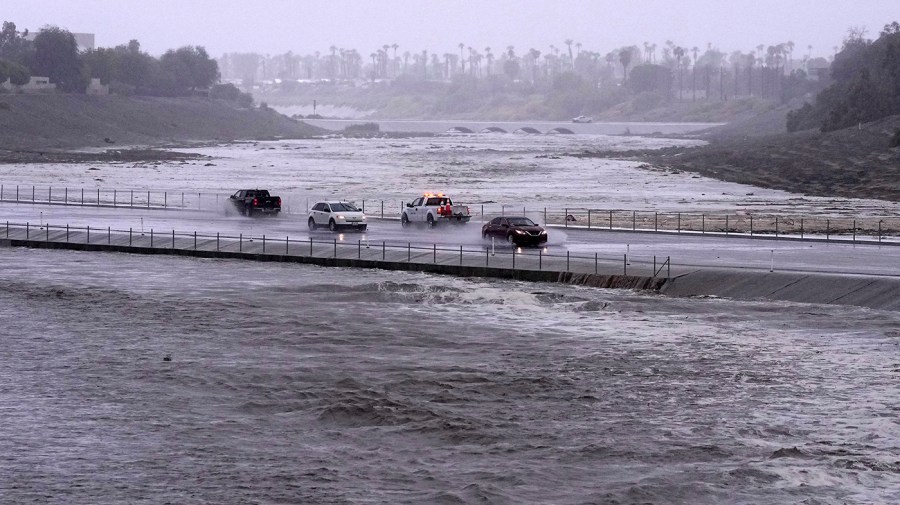California caught in crosshairs of weather extremes in a warming world
Southern Californians are surfacing from a historic weekend of weather extremes after what may have been the first tropical storm to hit California’s coast in 84 years.
Tropical Storm Hilary, a probable combination of natural El Niño patterns and human-induced warming, dumped 2.48 inches of rain on downtown Los Angeles on Sunday, shattering the previous August daily record of 0.03 inches set in 1906, the National Weather Service reported.
The tropical storm definitely hit Baja California, but there are questions over whether it actually made landfall in the United States as a tropical storm.
Either way, it was widely seen as a harbinger of the state’s severe weather challenges in the future amid a warming world.
“Right out of the gate, we have the potential for stronger storms, and we also have the potential for storms that strengthen very, very quickly,” James Kossin, an adjunct professor at the University of Wisconsin-Madison and consultant for the climate risk nonprofit First Street Foundation, told The Hill.
Hilary broke “virtually all rainfall daily records” and achieved “some impressive totals” across the region, the National Weather Service’s Los Angeles branch determined Monday.
Palmdale Airport received 3.93 inches of rain, breaking a record of 0.05 inches set in 1934.
Death Valley National Park reported 2.20 inches of rain Sunday, breaking last summer’s record of 1.70 inches, according to the weather service’s Las Vegas branch.
To complicate matters further, just hours after Hilary arrived Sunday, an unrelated magnitude 5.1 earthquake rattled areas southeast of the Ventura County city of Ojai, along the Sisar fault.
Wildfire relief

The storm did bring Southern California some tangible benefits by temporarily reducing the risk of wildfire in the region, according to Daniel Swain, a climate scientist at the University of California, Los Angeles.
“There’s likely to be a prolonged reprieve for weeks, at least in Southern California and in places that got soaked on the eastern side of Sierra as well,” he said at his virtual office hours Monday afternoon.
That said, the Northern California Deep Fire, which began last week, grew to more than 3,000 acres over the weekend and began ripping through the Shasta-Trinity National Forest in Northern California. By Tuesday, the fire had expanded to 3,823 acres and was only 5 percent contained, according to the U.S. Forest Service.
Hilary’s rainfall is not expected to offer significant relief from that fire.
Still, Swain stressed that aside from Northwestern California, fire season has been relatively “low-key” this year so far.
“California deserves a break after the last decade,” he said. “At some point, just by random luck, you’ve got to have another year that isn’t as crazy.”
But Swain also noted “the great irony” that California is experiencing such a respite when “almost everywhere else on Earth is experiencing almost continuously crazy, record-breaking, even record-shattering, heat extremes and flood events.”
California’s reprieve, he stressed, will presumably be “more of the exception rather than the norm moving forward,” after a decade of severe droughts, wildfires and extreme precipitation events.
Unique set of circumstances

Kossin, a former atmospheric scientist for the National Oceanic and Atmospheric Administration (NOAA), credited “a unique set of circumstances,” some natural and some mad-made, for Hilary’s development.
“What causes the warm water in this case is probably mostly the El Niño, and that is natural,” Kossin said. “But that’s not to say that there isn’t a human fingerprint on it. At this point, there’s a fingerprint on just about everything.”
Also at work was a giant “heat dome” — a high-pressure, circulating system that traps hot air — which was moving the airflow in a clockwise manner along the dome’s western edge, Kossin explained.
“Most of the time, these storms form and they just travel from east to west and move out to sea and maybe threaten Hawaii,” he said.
But with the so-called “steering flow” that accompanies the heat dome, winds from the south were steering the storm toward California, according to Kossin.
“Winds can change direction completely from one day to the next,” he said. “So that adds a certain amount of randomness to the whole thing.”
The weather service by early Monday had reclassified the storm as a post-tropical cyclone, which later moved on to soak Nevada before drenching Oregon and Idaho.
Although meteorologists are confident that Hilary first appeared on land in western Mexico, they are still trying to determine whether the storm also made a separate entrance from the ocean into California, rather than over the mountains east of San Diego.
“It’s clear that Hilary made an initial landfall in northern Baja California,” Swain said. “But what is less clear now — there may have actually been a second landfall.”
The storm appears to have traveled “more or less directly over San Diego” and parallel to the coastline, prior to “going inland directly over Los Angeles,” according to Swain.
“Did this storm end up being the first to have an actual California landfall at or above tropical storm strength since 1939?” the climate scientist asked.
The answer remains uncertain because “it was so close,” he explained, noting that “sports are not the only context where there’s postseason analysis.”
Acknowledging that the distinction doesn’t necessarily matter, Swain noted that this path could have caused Los Angeles and Ventura counties to see more rain than was initially anticipated.
Countering claims that minimize the storm’s effects as “minor street flooding,” Swain cited reports of “large debris flows that took out bridges, scoured canyons, knocked down long established trees and structures,” as well as residents who fled in the middle of the night.
He also noted that many of the interstates and highways across southeastern California were shut down entirely as the storm persisted.
But the damage could have been much greater had desert weather conditions earlier in the day Sunday been different — and had there been more sun over the Salton Sea rather than thick clouds, according to Swain.
While the area did receive almost the same amount of rain as predicted, stronger morning sunlight near the Salton Sea’s surface could have generated enough instability to maximize rain rates, he explained.
“There were certainly places that recorded rainfall rates of 1-2 inches per hour, but not 3-4 per hour,” the climate scientist said.
“It turns out that makes a huge difference,” he added, noting that flooding could have been twice as bad or worse.
The role of randomness

Emphasizing the role of randomness and the fact that daily variability played such an essential role in Hilary’s trajectory, Kossin, the Wisconsin-based atmospheric scientist, pointed out the difficulties in holding climate change responsible for this specific event.
Zooming out, however, it is possible to demonstrate a potential link between hurricane and tropical storm intensity and climate change — which Kossin and his colleagues revealed in a 2020 paper in the Proceedings of the National Academy of Sciences.
The researchers showed how maximum sustained winds in hurricanes are getting stronger, and that a warming planet may be responsible for this trend.
“You need a storm to be very strong so it can survive that trip across that cold California current,” Kossin said, noting that this usually bars storms from being named before reach the coast.
Not only did Hilary have that strength, but it also intensified very rapidly — a phenomenon that he described as “driven by ocean temperatures.”
The question remains, however, how much of that warming was the result of climate change and how much were due to of El Niño.
While many factors came together to influence Hilary’s development, the storm was probably “made more likely due to climate change,” according to Kossin.
“The likelihood of an event like Hilary is higher now than it used to be,” he added.
Copyright 2024 Nexstar Media Inc. All rights reserved. This material may not be published, broadcast, rewritten, or redistributed..











